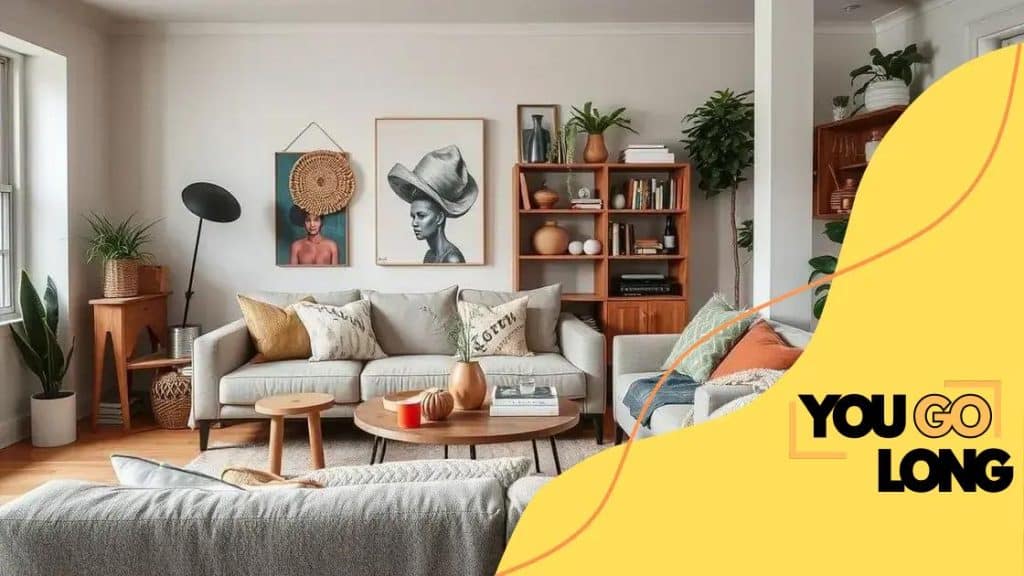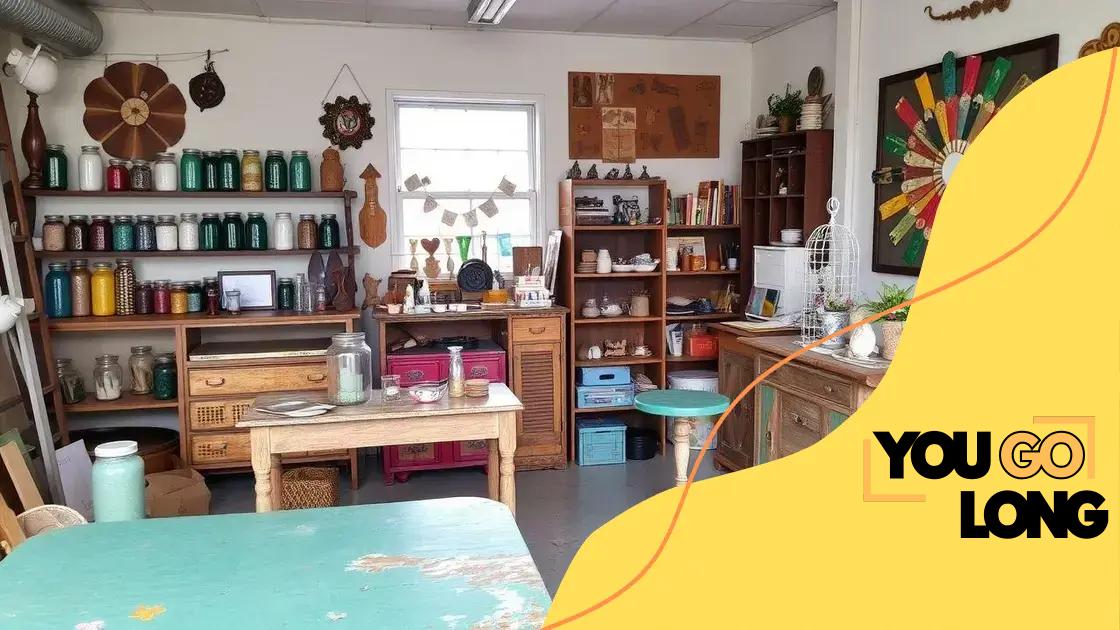Decorating with sustainable and upcycled materials

Advertisement
Decorating with sustainable and upcycled materials involves using eco-friendly and creatively repurposed items to enhance your home while minimizing environmental impact.
Decorating with sustainable and upcycled materials invites us to rethink our living spaces. Ever considered how creative reuse can not only beautify our homes but also benefit the environment? Let’s explore this fascinating trend.
Understanding sustainable materials
Understanding sustainable materials is crucial for anyone looking to decorate with purpose. Sustainable materials are sourced and produced in ways that minimize harm to the environment. They help reduce waste, conserve resources, and often come with unique character.
What are sustainable materials?
Sustainable materials include those that are renewable, recycled, and have a low environmental impact. Some common types are bamboo, reclaimed wood, and recycled metal. These materials not only look great but also tell a story of responsible sourcing and care for our planet.
Advertisement
Benefits of using sustainable materials
- They help reduce carbon footprint.
- Support local economies and artisans.
- Often more durable than conventional materials.
- Create healthier living spaces by reducing toxins.
When you choose sustainable materials, you’re making a conscious choice for both style and the environment. This can be a win-win situation, as these materials often showcase beautiful, natural aesthetics. For example, reclaimed wood beams can add rustic charm to any space, while eco-friendly textiles provide comfort and warmth.
How to identify sustainable materials
To ensure you’re picking the right materials for your projects, look for certifications. Labels from organizations like FSC or LEED indicate that materials come from sustainable sources. It helps to also do some research into the manufacturing processes to see if they align with your values.
Merging style with sustainability is not just feasible; it can lead to amazing designs that are both trendy and environmentally friendly. As you explore different options, consider how these choices impact your living environment and the world around you.
Advertisement
Benefits of upcycling in home decor
Upcycling is a fantastic way to breathe new life into old items. The benefits of upcycling in home decor are numerous and can transform your living space into something uniquely beautiful. By upcycling, you not only save money but also contribute positively to the environment.
Cost-effective solutions
One of the main advantages of upcycling is that it allows you to create stunning decor without breaking the bank. Instead of buying expensive new furniture or accessories, consider repurposing items you already own or find at thrift stores. This way, you can allocate your budget for other home improvement projects.
Unique and personalized decor
When you upcycle, each piece becomes a reflection of your personal style. You can customize colors, textures, and designs to match your taste perfectly. This results in home decor that stands out and tells a story, making your space truly one-of-a-kind.
- Transform old furniture into stylish statement pieces.
- Use jars and containers for creative storage solutions.
- Repurpose old fabric into cushions or wall art.
- Combine different materials for artistic home accents.
Another significant benefit is the positive environmental impact. Upcycling reduces waste by giving new life to items that might otherwise end up in landfills. By choosing to upcycle, you are actively participating in sustainability and helping to conserve natural resources.
Encouragement of creativity
Upcycling encourages creativity and innovation. It challenges you to think outside the box and find new uses for everyday items. This can make decorating your home not just a duty but a fun and rewarding project. You might be surprised by what you can create with a little imagination and effort.
Creative projects with upcycled items

Creative projects with upcycled items open a world of possibilities for enhancing your home decor. Not only do these projects save the environment, but they also allow you to express your personal style. By using items that might otherwise be discarded, you can create something new and exciting.
Types of Upcycled Projects
There are many ways to get started with upcycling, whether you’re a seasoned DIYer or just looking for a fun weekend activity. One popular project is repurposing furniture. An old dresser can become a vibrant TV stand with a fresh coat of paint and new hardware. Similarly, wooden pallets are great for building rustic shelves or garden planters.
Ideas for Upcycling
- Transform glass jars into stylish candle holders or vases.
- Use tin cans to create unique lanterns.
- Convert old t-shirts into trendy tote bags.
- Make art pieces from leftover wood scraps.
Another fun idea is to create wall art. Old frames can be painted and filled with fabric or paper for a colorful gallery wall that showcases your creativity. You can also use bottle caps or wine corks to make playful coasters or wall decor.
Getting Inspired
Finding inspiration for your upcycling projects can be as easy as browsing the internet. Many sites and social media platforms are filled with creative upcycle projects. You can also visit local thrift shops for unique items that inspire your designs. Join community workshops or online forums to share ideas and learn from others.
The thrill of transforming discarded objects into beautiful decor pieces is a rewarding experience. By engaging in creative projects with upcycled items, you not only enhance your home but also promote a sustainable lifestyle.
Tips for sourcing sustainable materials
Sourcing sustainable materials is essential for anyone looking to decorate responsibly. A few tips for sourcing sustainable materials can make a significant difference in your home projects. Understanding where to look and what to consider can help you make eco-friendly choices.
Research Certified Suppliers
Start by looking for suppliers who are certified in sustainability. Certifications from organizations like FSC (Forest Stewardship Council) or Cradle to Cradle provide assurance that the materials meet strict environmental and social standards. This can include right sourcing, ensuring fair labor practices, and utilizing clean manufacturing processes.
Explore Local Options
Shopping locally can be a fantastic way to find sustainable materials. Local woods can often be sourced without significant transportation emissions. Visit local furniture makers, craft fairs, or farmers’ markets to discover reclaimed materials or artisans working with sustainable products. This supports your community and reduces your carbon footprint.
- Check out local salvage yards for unique upcycled materials.
- Use flea markets to find vintage items that can be repurposed.
- Connect with local eco-friendly businesses for innovative products.
- Consider DIY workshops that might offer sustainable crafting sessions.
Networking with other eco-conscious individuals can also inspire you to find unique materials. Online forums and social media groups dedicated to sustainability in decor can introduce you to resources you might not have considered. You may discover tips on where to buy materials and even exchange items you no longer need.
Prioritize Quality Over Quantity
When sourcing materials, consider investing in high-quality options that are durable and long-lasting. This might mean paying a bit more upfront, but it pays off in longevity. Durable materials reduce waste and the need for frequent replacements. Look for handmade or artisanal pieces, which often have a longer life cycle than mass-produced options.
By following these tips, you can confidently source sustainable materials that enhance your home while protecting the planet. Engaging in this process helps create a space that reflects your values and encourages a healthier environment.
Transforming spaces sustainably
Transforming spaces sustainably is about making eco-friendly choices while enhancing the beauty and functionality of your home. With a little creativity, you can make significant changes that reflect your values and style without harming the planet.
Choosing Sustainable Materials
The foundation of any sustainable transformation starts with sustainable materials. Look for items that are renewable, recycled, or locally sourced. For example, bamboo, reclaimed wood, and recycled metal are excellent choices that not only reduce waste but also add character to your space.
Eco-Friendly Design Practices
Incorporating eco-friendly design practices can significantly impact the sustainability of your home. Consider using low-VOC paints and finishes to minimize indoor air pollution. You can also enhance natural light in your rooms by using mirrors or selecting lighter colors for walls, which can reduce energy consumption.
- Utilize energy-efficient lighting options like LED bulbs.
- Install programmable thermostats to manage energy usage.
- Choose furnishings that are sustainably made and free of harmful chemicals.
- Incorporate plants for better air quality and natural beauty.
Another effective way to transform your space is by embracing multifaceted furniture that serves multiple purposes. For instance, a coffee table that doubles as a storage unit maximizes space while reducing clutter. This type of design is not only practical but also supports a more sustainable lifestyle.
Creating a Connection with Nature
Integrating natural elements into your decor can create a calming environment. Use natural textiles for curtains and cushions, and incorporate wooden accents throughout your home. Bringing nature inside not only improves aesthetics but also promotes well-being and mindfulness.
By focusing on transforming spaces sustainably, you can create a home that is both stylish and responsible. This approach allows you to enjoy a beautiful environment while contributing to a healthier planet, making a positive statement about your lifestyle.
In conclusion, transforming your space sustainably is achievable and rewarding. By choosing sustainable materials, embracing eco-friendly design practices, and integrating natural elements, you can create a beautiful, responsible home. Every small change contributes to a healthier planet, making a positive impact on your lifestyle and the environment. Remember, decorating sustainably is not just a trend; it’s a commitment to a better future!
FAQ – Frequently Asked Questions about Sustainable Decorating
What are sustainable materials?
Sustainable materials are sourced and produced in ways that minimize harm to the environment, including recycled and renewable options like bamboo and reclaimed wood.
How can I incorporate upcycled items into my decor?
You can transform old furniture, use glass jars as vases, and even make art pieces from leftover materials to creatively enhance your home.
What are the benefits of decorating sustainably?
Decorating sustainably helps reduce environmental impact, supports local economies, and can create unique, personalized spaces that reflect your style.
Where can I find sustainable materials for home projects?
You can source sustainable materials from certified suppliers, local thrift stores, salvage yards, and community workshops focused on eco-friendly practices.





